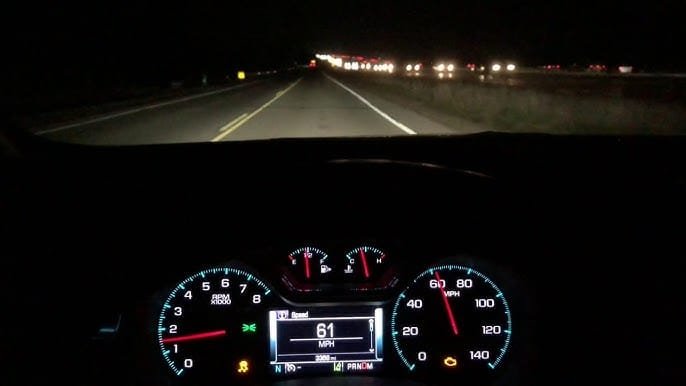Few things are as frustrating as seeing the “Engine Power Reduced” warning pop up on your Chevy Impala‘s dashboard. This issue can appear unexpectedly, leaving you with diminished acceleration and a vehicle that seems to struggle with basic performance.
If you’ve faced this problem, you’re not alone—this is a common concern among Chevy Impala owners, particularly in models equipped with advanced throttle systems. But what causes this warning, and how can you resolve it effectively?
In this detailed guide, we’ll explore the underlying reasons behind the “Engine Power Reduced” message, its impact on your vehicle’s performance, and actionable steps to fix it.
Whether you’re dealing with a faulty throttle body, a failing sensor, or a software glitch, we’ll provide a clear roadmap for diagnosis and repair. Let’s dive in and ensure you’re prepared to tackle this problem with confidence.
What Does “Engine Power Reduced” Mean?
The “Engine Power Reduced” warning is a safeguard built into modern vehicles like the Chevy Impala. This feature, part of the engine’s electronic control module (ECM), is designed to protect your engine from damage when a fault is detected in critical systems.
Essentially, the ECM limits your car’s power to prevent further damage and keep you safe.
When this warning activates, it often feels like the car is struggling to accelerate, and you may experience sluggish performance, even at higher speeds.
While this mode can be frustrating, it serves as a protective measure to give you time to address the issue without risking severe engine damage.
Common Causes
- Throttle Body Malfunction
The throttle body controls the airflow entering the engine. If it becomes dirty or fails due to mechanical wear, the ECM may detect irregular airflow and activate the reduced power mode. - Faulty Throttle Position Sensor (TPS)
The TPS monitors the position of the throttle and communicates with the ECM. If it malfunctions, incorrect data can trigger the warning. - Accelerator Pedal Position Sensor Issues
Similar to the TPS, this sensor monitors the position of the accelerator pedal. A malfunction can confuse the ECM, leading to reduced engine power. - Wiring Problems or Loose Connections
Faulty or damaged wiring in the throttle or sensor systems can disrupt communication between components, causing the ECM to limit power. - Mass Airflow Sensor (MAF) Failure
The MAF measures the amount of air entering the engine. If it sends inaccurate data, the ECM may activate the reduced power mode to prevent engine strain. - Software or ECM Glitches
Occasionally, software issues in the ECM can cause false warnings. Resetting or updating the system may resolve the problem. - Other Component Failures
- Malfunctioning oxygen sensors
- Clogged catalytic converters
- Low fuel pressure or failing fuel pumps
Diagnosing the Issue
Proper diagnosis is crucial to identify the exact cause of the reduced power warning. Follow these steps to pinpoint the problem:
- Check for Error Codes
Use an OBD-II scanner to retrieve diagnostic trouble codes (DTCs) from the ECM. Codes like P2135 or P2101 often indicate throttle-related issues. - Inspect the Throttle Body
Examine the throttle body for dirt, carbon buildup, or mechanical wear. A visual inspection can often reveal obvious problems. - Test Sensors
Check the functionality of the TPS, accelerator pedal position sensor, and MAF sensor using a multimeter or diagnostic tools. - Inspect Wiring and Connections
Look for loose, frayed, or corroded wires in the affected systems. Ensure all connections are secure. - Evaluate Fuel System Performance
If no obvious electrical faults are found, inspect the fuel system components, including the pump and injectors, to rule out fuel delivery issues.
How to Fix the Problem
- Clean or Replace the Throttle Body
- Cleaning: Use throttle body cleaner to remove dirt and debris.
- Replacement: If cleaning doesn’t resolve the issue, replace the throttle body with a new one.
- Replace Faulty Sensors
- TPS and accelerator pedal position sensors are common culprits. Replace them as needed.
- Repair Wiring
Fix or replace any damaged wires or connectors to ensure proper communication between components. - Update or Reprogram the ECM
If the issue stems from a software glitch, an ECM update or reprogramming may resolve the problem. - Address Fuel System Issues
Replace failing fuel pumps or clogged injectors to restore proper fuel delivery. - Replace Other Components
- Oxygen sensors or catalytic converters may require replacement if they are contributing to the problem.
Preventive Measures to Avoid Reduced Power Warnings
- Regular Maintenance
- Clean the throttle body and MAF sensor during routine servicing.
- Replace air and fuel filters on schedule.
- Monitor Sensors and Wiring
Periodically inspect sensors and wiring for wear or damage to catch potential issues early. - Use Quality Fuel and Additives
High-quality fuel and periodic use of fuel system cleaners can help prevent buildup and maintain optimal engine performance. - Stay Updated on Software
Check with your dealership for ECM updates that address known issues.
Frequently Asked Questions
1. Can I drive my Chevy Impala with the “Engine Power Reduced” warning?
Yes, but it’s not recommended for extended periods. Reduced power mode limits your car’s performance to prevent damage, but prolonged use can strain other components.
2. How much does it cost to fix the “Engine Power Reduced” issue?
Costs vary depending on the root cause. Sensor replacements can range from $100 to $300, while throttle body repairs may cost $200 to $500. ECM reprogramming or updates typically cost $150 to $300.
3. Is the “Engine Power Reduced” warning unique to Chevy Impala models?
No, this issue can occur in various vehicles with electronic throttle control systems. However, Chevy Impala owners commonly report this warning due to throttle or sensor problems.
Conclusion
The “Engine Power Reduced” warning in your Chevy Impala can be frustrating, but it’s a manageable issue with proper diagnosis and timely repairs. Understanding the potential causes—from throttle body malfunctions to sensor failures—empowers you to address the problem effectively.
With regular maintenance and attention to your vehicle’s systems, you can minimize the likelihood of encountering this warning in the future.
If you’re unsure about any repair or diagnostic step, don’t hesitate to consult a professional mechanic to ensure your Chevy Impala stays in peak condition.





